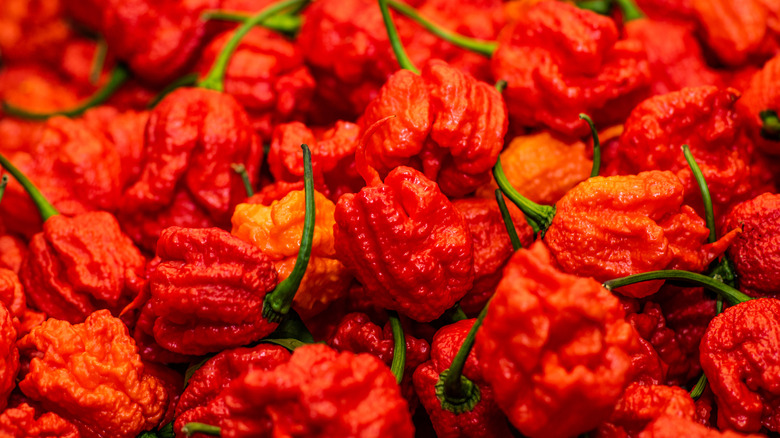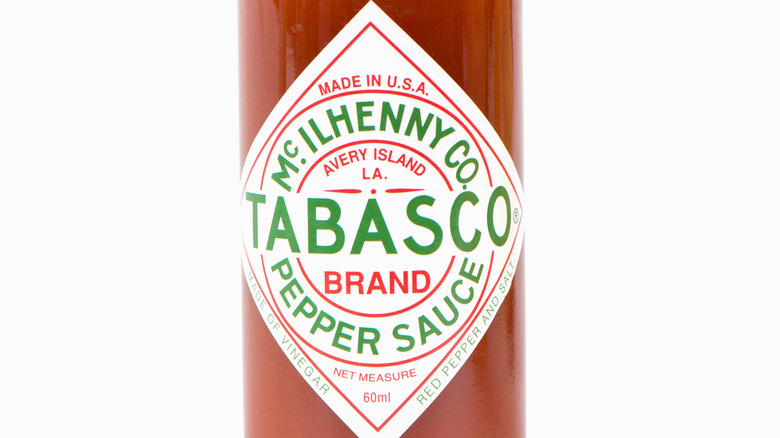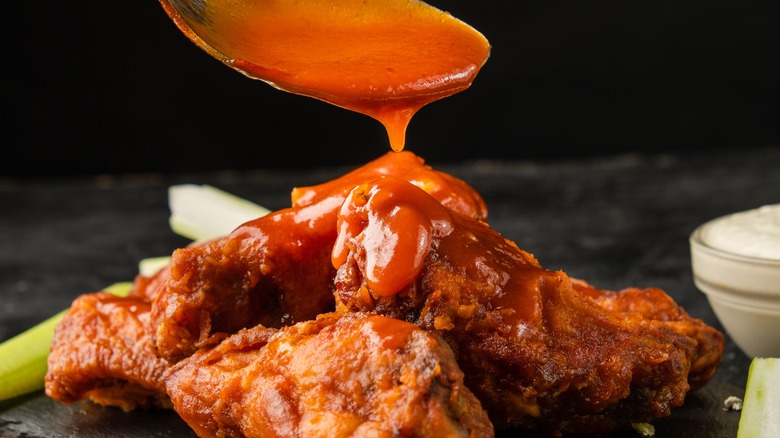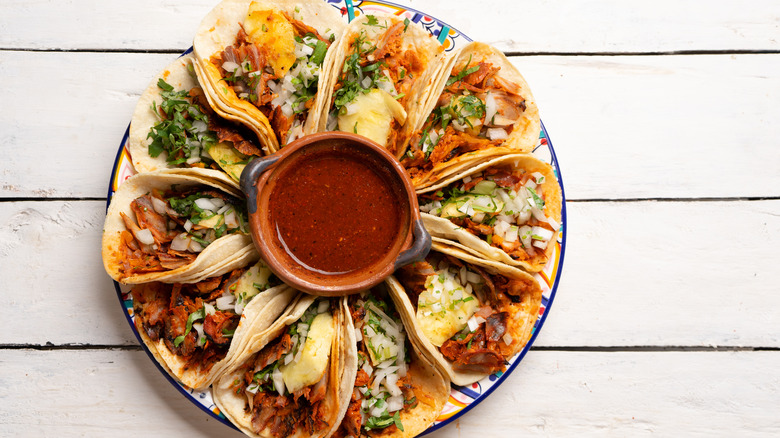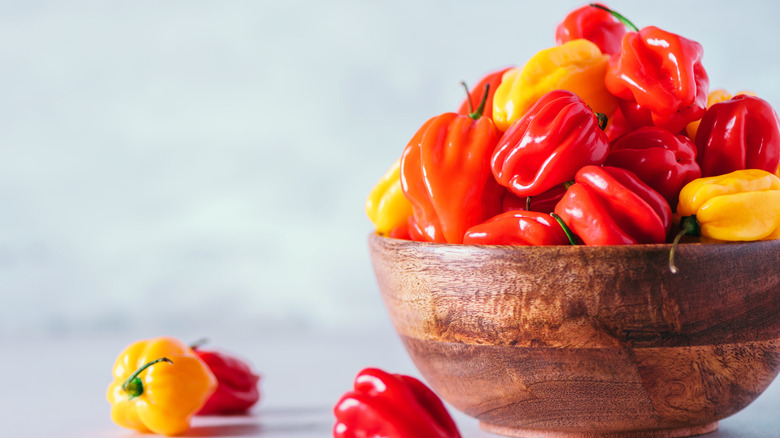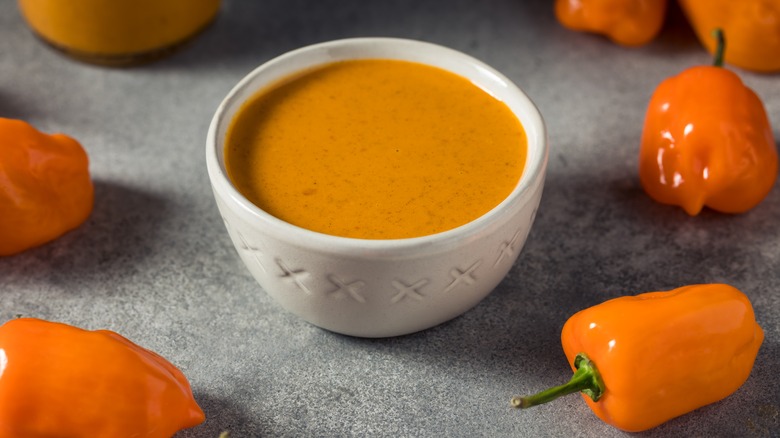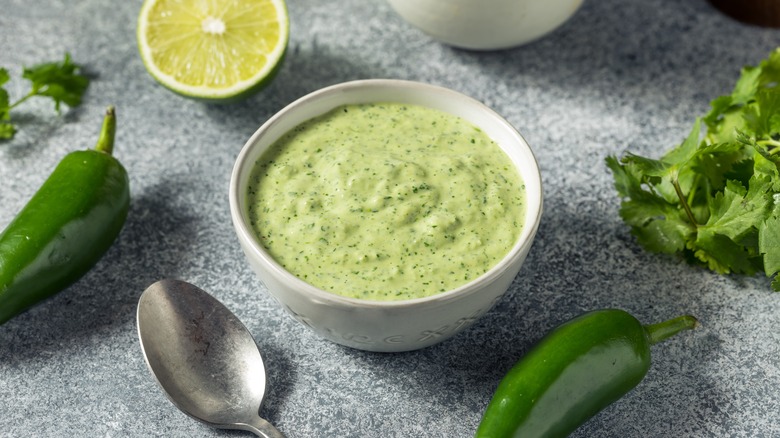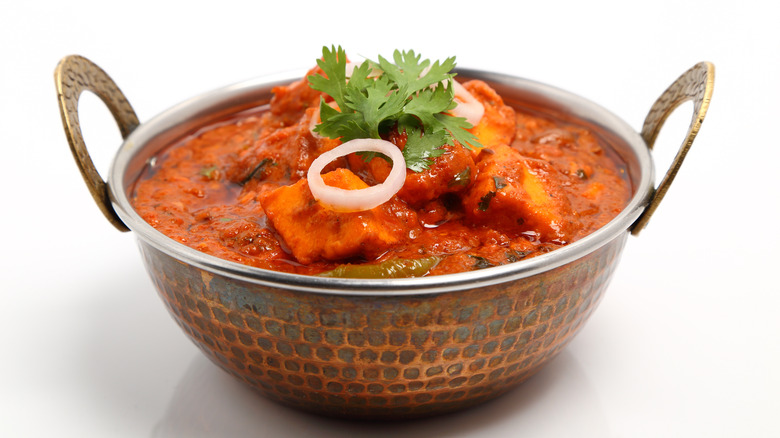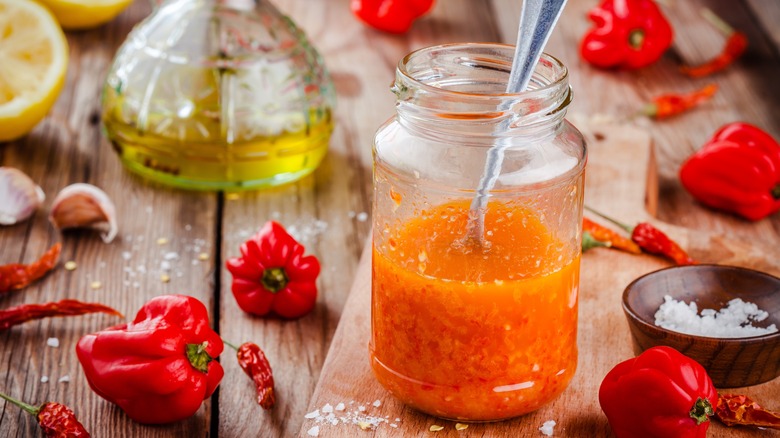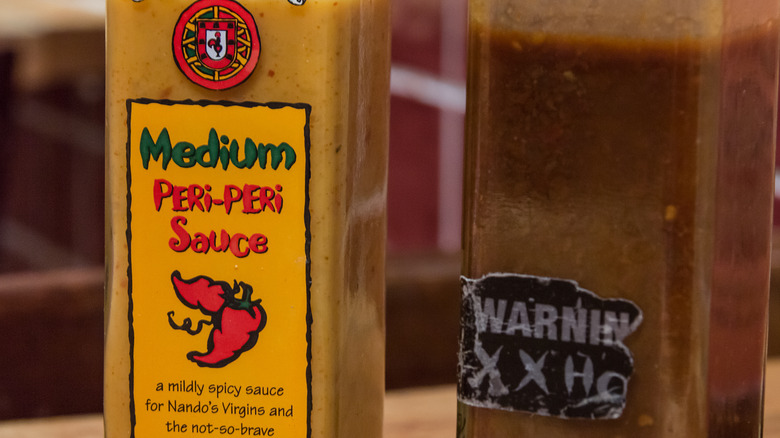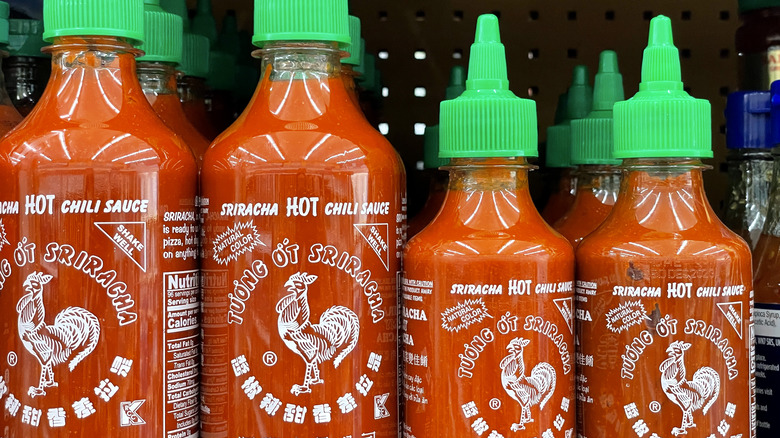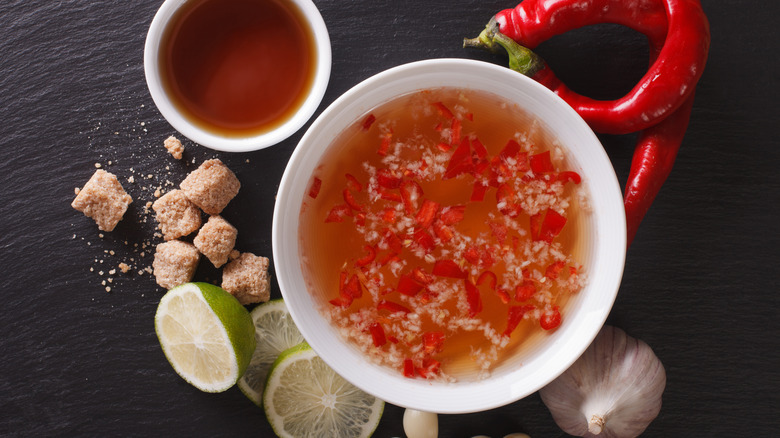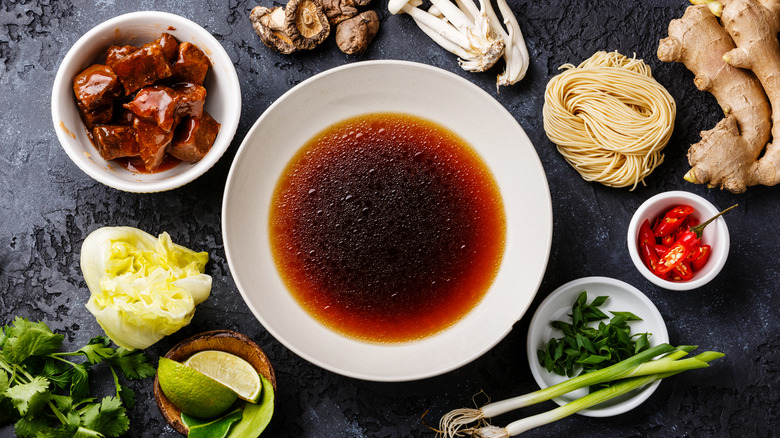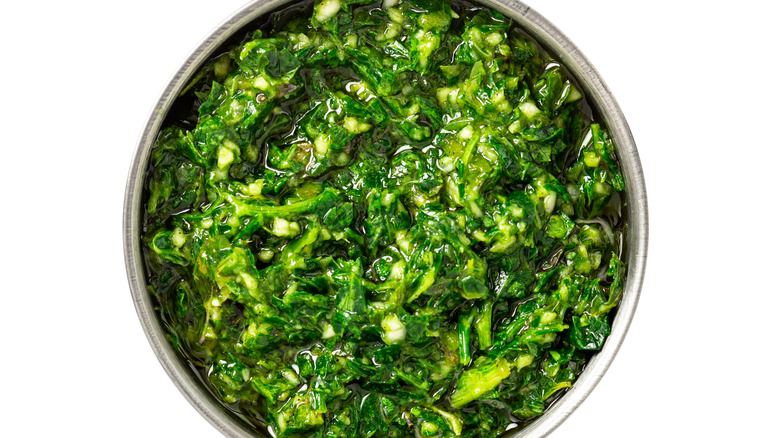15 International Hot Sauces And What Makes Them Unique
Certain dishes pop up in different local cuisines from all over the world, and sometimes it's hard to explain how they are linked to each other. Such is the case with hot sauces, a diverse ingredient that's also beloved all over the world.
According to Pepper Scale, archaeologists found proof that peppers were consumed around 7000 B.C. Made with hot peppers, hot sauces have fascinated humanity's taste buds for thousands of years. Today, there are literally thousands of hot sauce varieties. Using countless chili types, hot sauces vary in levels of heat, flavors, consistency, and color. According to the region of the world, hot sauces share certain characteristics. For instance, South American hot sauces can share a coriander flavor, while Caribbean hot sauces are sometimes combined with tropical fruit (per Chili Workshop). Whether you're seeking subtle sweetness or the bursting flavors of umami or earthy peanuts, there is always something to enjoy in a hot sauce.
Pepper X sauce
If you're looking for the absolute hottest sauce, the creator of the Carolina Reaper chili has come up with even a hotter pepper, making pepper X the hottest existing chili in the world. According to Today, Ed Currie developed the pepper by accident while researching ways to help fight cancer. He came up with a pepper type that totals 3.18 million Scoville units, more than double the amount of Scoville units in a Carolina Reaper pepper. Working together with Noah Chaimberg, the founder of the hot sauce company Heatonist, Currie developed a sauce called The Last Dab, which is marketed as the hottest sauce ever created.
The sauce is made with three types of peppers (pepper X, chocolate pepper X, peach pepper X) and is flavored with turmeric, coriander, and cumin. The earthy and zesty flavors enhance the fiery aroma of the peppers, cranking up the heat. The spice actually hits after 40 seconds, which means that the sauce should be consumed with precaution, as its effects are not immediate. Designed for the most adventurous heat seekers, The Last Dab goes well with any food type, emphasizing endorphin-releasing hotness.
Louisiana-style sauce (U.S.)
As there are hundreds of hot sauce varieties in every cooking culture and tradition, there are at least as many subtle differences between hot sauce types. The thing is that these differences are essential in using the sauce, as certain types go wonderfully with some foods, while others simply don't click, taste-wise. A staple of U.S. cooking, the Louisiana-style sauce is a combination of chilies, vinegar, and salt. The best-known brand for this type of sauce is Tabasco. Because the vinegar taste is strong and there are almost no spices to divert it, the Louisiana-style sauce is an ideal fit for foods containing lots of fat, such as fried chicken and seafood.
However, as vinegar is acidic, Louisiana-style sauce is not a good fit for already acidic foods, according to The Washington Post. Some examples of acidic foods include tomatoes, lemons, and grapefruits, so avoid using the sauce in combination with any of these. But what if you want to spice up a tomato-based sauce or stew? Apparently, the answer to this is the Mexican-style hot sauce Picante, which is closely related to the Louisiana-style sauce. The acidity levels represent the difference between the two: while the Louisiana sauces are acidic, the Picante hot sauces focus on flavor. This is why Picante sauces are better suited to use in soups or stews or traditional Mexican dishes.
Buffalo sauce (U.S.)
Traditionally used to coat the well-known Buffalo wings, the fatty and finger-staining Buffalo sauce is made using Louisiana-style sauce and butter. According to Time, the sauce was invented in 1964 by Teressa Bellissimo, who owned the Anchor Bar in Buffalo, together with her husband, Frank. She used her signature sauce, made with melted butter, hot sauce, and red pepper, to coat chicken wings, which were already deep fried, and served them with blue cheese and celery. In time, Frank's RedHot has become an iconic ingredient for Buffalo sauce.
Of course, nowadays, the recipe has lots of variations and ingredients, depending on taste. For more umami, you can add roasted garlic (or garlic confit). If you're in the market for vegetarian dishes, you can try Buffalo-style tofu or cauliflower. Restaurants all over the country are serving countless reinterpretations of the Buffalo wing sauce paired with unique ingredients. Buffalo Chinese-style buns and Buffalo oyster mushrooms are just two examples of what a creative chef can make, starting from a not-so-glamorous recipe.
Chile rojo (Mexico)
Chile rojo is a base sauce of Mexican cuisine, made using toasted dry chilies and spices. Depending on personal preferences, some traditional Mexican recipes will not add tomato to Chile rojo. To other chefs, the tomato is a welcome addition, as it can enhance the flavor. The sauce can be served with enchiladas or tamales, but it can also constitute the base of stew-style dishes, such as Chile Colorado.
Chile rojo uses an assortment of dried chilies with different flavors and heat levels. For example, dried guajillo chilies, ancho chilies, and pasilla chilies go well together in the Chile Colorado recipe. When using dried chilies, it's advisable to check the expiration date, as they tend to preserve their flavor for approximately six months. Also, dried chilies should have their seeds removed before cooking. A perfect way of enhancing their flavor is toasting the dried chilies, but you should be careful not to burn them, as they will turn bitter. To make chile rojo, the toasted chilies are cooked in chicken stock with some onions and then blended and strained. Finally, the sauce is flavored with cumin, oregano, and crushed garlic cloves and can be used as is or added to stews.
Scotch bonnet pepper sauce (Jamaica)
A type of hot pepper native to the Caribbean, the scotch bonnet pepper is spicy, similar to habanero in terms of heat (via Pepper Scale). Unlike the habanero, it has a sweet, tropical flavor. The taste is reminiscent of tomatoes but also apples and cherries. As with other chilies, the flavor and the heat will depend on the climate and soil where the plant grows. According to Forbes, the scotch bonnet pepper is so representative of Caribbean cooking that the increased demand for local products has led to a shortage of raw pepper, the main ingredient used in Caribbean sauces.
Jamaica is the most important scotch bonnet producer of both raw peppers and hot sauces. The typical Jamaican scotch bonnet pepper sauce usually plays into the dominant tropical flavors of the chili, which are enhanced with the help of tropical fruit, such as pineapple and mango. For a zestier taste, the sauce often includes onion, carrot, garlic, and lime juice. Another typical flavor twist is the use of cumin. The sauce goes wonderfully with chicken and fish, but it can also be added to soups, stews, and other dishes.
Sauce Ti-Malice (Haiti)
Haiti's most representative hot sauce, sauce Ti-Malice gets its name from a local legend, the tale of Uncle Bouki and Ti Malice. Inspired by the folklore of Ghana, Ti Malice is a trickster character who uses Uncle Bouki's greed to make fun of him. Sauce Ti-Malice is made using scotch bonnet peppers or habanero pepper, as it is meant to be particularly hot. Similar to the Jamaican Scotch bonnet sauce, sauce Ti-Malice may contain tropical fruit (tangerines), which enhance the citrusy note. The earthy notes of the thyme complete the fresh burst of citrus, rounding up the sauce to a well-balanced flavor.
Sauce Ti-Malice includes hot peppers, oil, tomato sauce, lemon juice, garlic, and thyme. The sauce is not very easy to come by in bottled form. The company Gindo's produced a limited edition of sauce Ti-Malice made from habanero peppers with an enhanced citrus flavor from tangerine and lemon juice. Sauce Ti-Malice can be used as a dip or spread to accompany meat, poultry, and seafood or as an addition to sandwiches or in stews.
Aji sauce (Peru)
Aji amarillo is a type of hot pepper from Peru which is a staple of the country's cooking. According to Pepper Scale, aji amarillo (translated as yellow chili) is one of the base ingredients of traditional Peruvian cooking. The pepper is not only yellow, as it ranges in color from yellow to green and bright orange, depending on maturity. It belongs to the Capsicum baccatum family, which is originally from the Andes mountains in South America. These peppers differ from the ones native to the U.S., which belong to a different pepper family.
Aji amarillo is a flavorful pepper with tropical hints of mango and passionfruit, but also raisin. It is a fiery pepper, in the same range as cayenne and tabasco peppers but lower than the scotch bonnet or habanero peppers. The typical aji amarillo sauce is unique because it contains, aside from peppers, mayonnaise, onions, lime juice, and queso fresco. Unlike other hot sauces, it's creamy and has a bright yellow or green color. The sauce accompanies many Peruvian dishes, such as fried yuca or papas a la Huancaína and fried chicken or French fries.
Phall (Indian)
Phall is a type of curry originating from British Indian cuisine, created in the U.K. by Indian immigrants. Considered to be the hottest kind of curry (the recipe sometimes calls for eight types of peppers), phall contains both habanero peppers and scotch bonnet peppers (some pretty spicy pepper varieties). To top this, according to Secret New York City, the Brick Lane Curry House in New York makes phall using the Carolina Reaper, one of the hottest pepper breeds in the world.
Aside from the impressive quantity of peppers, phall is a unique hot sauce as it uses a lot of spices specific to Indian cooking. It is a tomato-based curry flavored with garlic, ginger, paprika, cardamom, turmeric, and cumin. These are proof enough that phall is not only hot but also comes with an explosion of aromas. What's interesting, according to Curry Culture, is that phall has become representative of British cuisine, with some restaurants offering special prizes to the customers who can eat an entire serving of the dish.
Habanero hot sauce (Belize)
Habanero is a type of hot chili with lots of heat and a unique citrusy taste, completed by a subtle smoke undertone. It originates from South America, is believed to have been domesticated over 8000 years ago, and has wide varieties and colors. Being a flavorful chili with lots of fruity aromas, the habanero is used as a base in many hot sauces, and it pairs well with tropical fruits, apples, and oranges. The best-known habanero hot sauce is the Belizean kind, originally prepared by a small company belonging to Marie Sharp.
According to Belize Magazine, Marie Sharp developed her trademark sauce when she was stuck with a large quantity of habanero pepper mash and started experimenting with recipes. She eventually found a winning formula when she mixed the peppers with home-grown carrots. The carrot-habanero sauce, which she dubs the Original Fiery Hot Pepper Sauce, is her company's most representative product. As interest in local cuisines and Belizean tourism grew, so did the sales of her hot sauce. Marie Sharp's habanero sauce came to be one of the most sought-after products of Belize, so the business expanded internationally. The habanero hot sauce is best suited for Belizean stewed chicken, rice and beans, and eggs.
Peri peri (Portugal)
The peri-peri sauce is the key ingredient to peri-peri chicken, a recipe that made Portuguese flavors known worldwide. The sauce recipe combines cooking techniques and ingredients originating from both Europe and Africa. According to Today, Portuguese colonizers in West Africa combined their cooking methods with local ingredients, such as the African bird's eye chili, resulting in a dish called piri-piri chicken. The most important African influence is the use of the local pepper, a small chili that was originally found in the African wild. It enhanced the heat of the Portuguese hot sauce, called piri-piri or peri-peri (in Portuguese).
The best-known peri-peri bottled sauce brand is Nando's, which uses chilies grown in Mozambique to produce the sauce. It is flavored with lemon, garlic, smoked paprika, cilantro, basil, and vinegar to give it its unmistakable flavor. It pairs excellently with chicken and seafood, but it's also great on avocado toast, scrambled eggs, or roasted vegetables. The original piri-piri chicken recipe requires the chicken to be marinated in the sauce for 24 hours and then grilled so that the flavor really engulfs the meat.
Sriracha (Thailand)
A sauce presumably originating in Thailand in the town of Si Racha, sriracha became famous in the U.S. when it started to be produced by Huy Fong Foods, a local company in Irwindale, California. Although there are countless sriracha versions available, the so-called "Rooster Sauce" is probably the best-known. The Huy Fong Foods sriracha was featured in a documentary presenting the origins of the sauce and some of its most devoted fans. Created by David Tran, a Vietnamese immigrant in America, the Huy Fong sriracha contains the same simple ingredients as the original recipe. It contains chili peppers, vinegar, garlic, sugar, and salt. The pepper-garlic-sugar combination gives sriracha its specific taste and is the reason the sauce has acquired legions of fans.
According to Los Angeles Times, the Thai version of the sauce has more sugar and a runnier texture compared to the one produced in America. The sauce appeals because the flavors are very well-balanced, and the sweet taste is not overwhelming, making you come back for more, plus offering a decent amount of heat. Sriracha is also very versatile in combination with different foods, goes well with both meat and vegetables, and can be used as a dressing. It can also become an interesting ingredient in spicy desserts, as it has enough sugar.
Vietnamese chili-garlic sauce (Nuoc Cham)
Nuoc Cham is a unique hot sauce from Vietnamese cuisine. In all the versions of the sauce, the one-of-a-kind aroma comes from the use of the fish sauce. Different flavors are added to this, such as ginger and garlic, and everything is topped with more sugar and lime juice. These all add up to lots of umami combined with tanginess, sweetness, and heat. It is a staple of Vietnamese cooking, and it goes well with all Vietnamese dishes, from summer rolls to vermicelli noodles, cucumber salad, and steak. It can also be used for other dishes, such as sticky rice cake, dumplings, or spicy noodle cake.
For an interesting take on Nuoc Cham, chef Tin Vuong uses original ingredients to increase the heat of the sauce. Developed for the Little Sister restaurant in Los Angeles, the chef's Red Nuoc Cham includes both sriracha and sambal for more spice, and the usual flavors of ginger, garlic, lemon, and fish sauce. This Nuoc Cham version is ideal for banh mi sandwiches.
Sauce d'arachide (Ivory Coast)
A traditional and representative dish in West Africa, sauce d'arachide (peanut sauce) is a hot sauce that uses the earthy taste of peanuts to bring out both the heat and the flavors. According to Food Service Magazine, sauce d'arachide represents one of the most sought-after international dishes in the U.S., as the interest in West African cooking has increased during the past years. The sauce is typically cooked for the traditional maffe, a dish incorporating meat, but can also be served with vegetables or rice.
Taste Atlas places the sauce in the traditional cuisine of the Ivory Coast, but it can also be found in Cameroon. Sauce d'arachide has a characteristic taste that comes from the freshly-ground peanuts and their strong flavor and, of course, the chilies. The peanuts are mixed with chili, onions, and tomatoes and flavored with garlic. The resulting sauce can be combined with any type of meat, but smoked fish is especially recommended, as the flavors complement each other nicely. It can also be served with all kinds of starchy vegetables, but rice is considered best, as it soaks up the creamy texture and the rich flavors.
Japanese Miso Fermented Hot Sauce
Every year, pepper enthusiasts are on the lookout for the latest editions of their favorite hot sauces, the ones that carry the most heat or the latest trends. The Scovie Awards competition is a contest where hot sauce producers can showcase their products, which are judged by a professional tasting division. Among the hot sauces awarded in different categories in 2022, Sabarac's Japanese Miso Fermented Sauce won first place in the mild/medium category. The Australian company Sabarac produces truly unique hot sauces, tapping into different culinary traditions and associating unexpected flavors.
The Japanese Miso Fermented Sauce represents a combination of fermented chilies and red fava bean miso. With a strong umami flavor, the sauce offers a galaxy of tastes as it is hot, salty, sour, and earthy at the same time. Alongside bird's eye chilies and red fava bean miso, the sauce is made with carrots, daikon, ginger, garlic, mirin, champagne, and rice wine vinegar. It goes well with any Japanese dish but is also very good with simple rice. This is truly a unique sauce that combines tastes belonging to very different culinary traditions.
Schug (Middle East)
A staple dish in the Middle East, schug is the go-to sauce for many local dishes in Israel or Yemen. It is a fresh green pepper sauce that differs in color from most hot sauces, which are usually red, orange, or yellow. The original schug recipe calls for fresh green chilies (20 serrano chilies), garlic, parsley, cilantro, and lemon juice. But modern culinary creativity called for certain additions to the ingredients, so that different restaurants and different chefs now offer upgraded schug versions.
Chef Michael Solomonov (Zahav restaurant, Philadelphia) uses an upgraded schug recipe, in which he adds cardamom and coriander to the parsley and cilantro. These will bring a flowery and citrusy note to the sauce, which is enhanced by the lemon juice and also tones down the intensity of the garlic. Schug is excellent with breakfast scrambled eggs, but also very good when added to another Middle Eastern dish, shakshuka. It's also very good with fresh fennel and tomatoes, for marinating chicken or for coating grilled meat.

